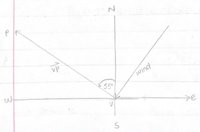This question has me really stuck because I can't seem to figure out how the diagram would look. Any help would be greatly appreciated!
A pilot wishes to fly her plane from Vectortown to Primeville, 850km away in the direction [N55W]. Her plane can fly 310km/h in still air, and the wind is measured coming from the northeast. The speed of the wind is 201km/h. In which direction should the pilot head the plane?
A pilot wishes to fly her plane from Vectortown to Primeville, 850km away in the direction [N55W]. Her plane can fly 310km/h in still air, and the wind is measured coming from the northeast. The speed of the wind is 201km/h. In which direction should the pilot head the plane?


